|
BULB LOG 20 16th May 2005
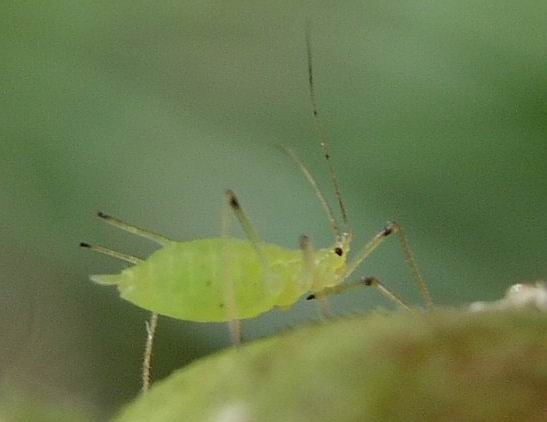
Aphid
A reminder and a warning that these wee pests are about in big numbers just now. I have been spraying my bulbs in the glasshouses, with a systemic insecticide while they are still green enough to absorb it into their system before they go dormant.
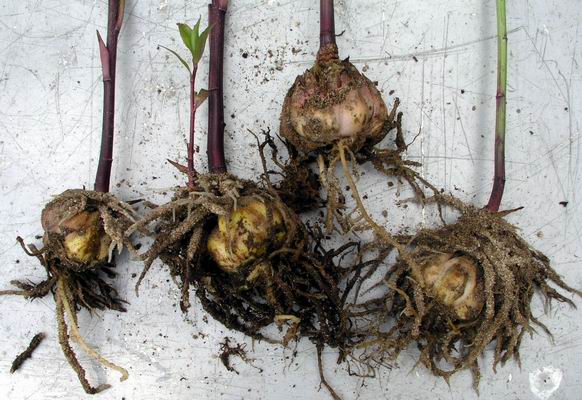
Lily bulbs
It is important to plant your lily bulbs at a good depth in the ground because many form stem roots just above the bulb as you can see in the above picture. It is these roots that will provide most of the water and nutrient to the flowers and leaves so it is essential that the bulb is deep enough for these to form effectively - a good mulch of leaf mould when they are in growth will also be beneficial.
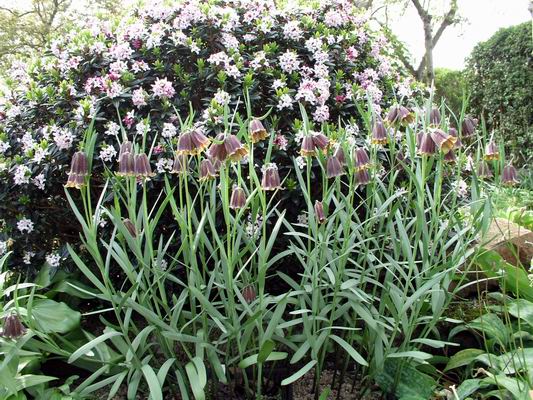
Fritillaria pyrenaica twin
The tall growing form of Fritillaria pyrenaica that I call the twin, because it has two flowers per stem when mature, is one of many forms we have. I have always collected all the forms of this plant that I have seen offered and of course I also raise it from seed, so that we have a number of very different forms around the garden.
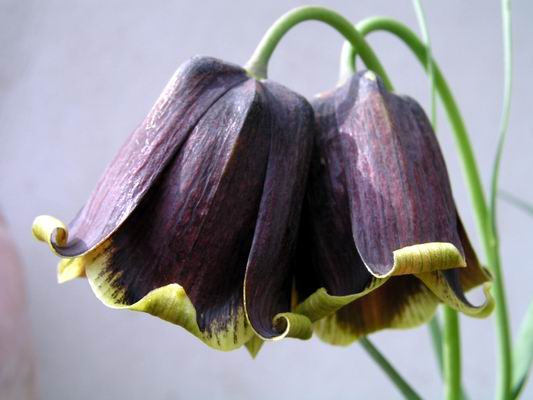
Fritillaria pyrenaica 1
Typical of this flower is the dark colour on the outside of the petals and the golden often checkered interior - this particular flower also displays nice recurving petals.
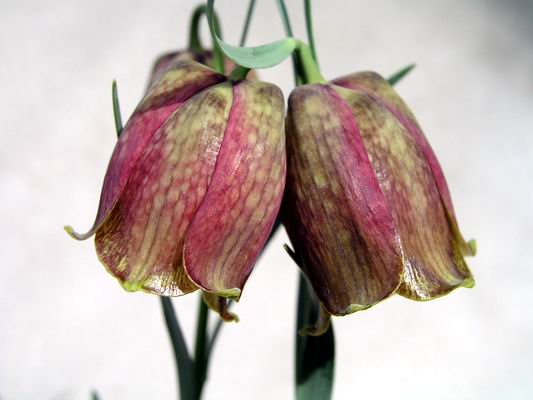
Fritillaria pyrenaica 2
This is also Fritillaria pyrenaica showing an interesting red tinge over yellow, quite unusual.
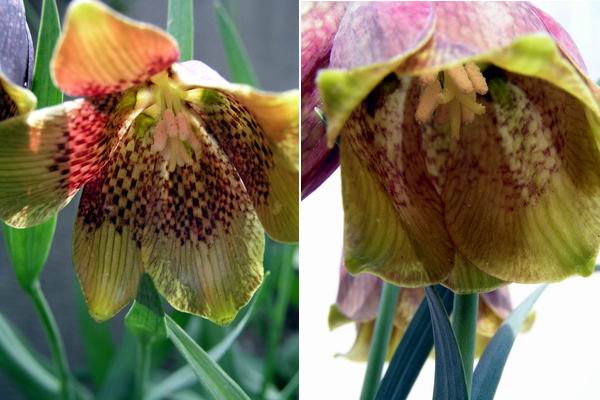
Fritillaria pyrenaica inside
The insides of the flowers also show some variation but to a lesser degree. We also have the yellow form but none are flowering this year - I find it a bit miffy to grow. As soon as we get a good display of it and are feeling pleased with our achievement it goes back and we have been on the edge of losing it completely a number of times. As a general rule Fritillaria pyrenaica prefers to be grown in the open ground as it seems to dislike the conditions sometimes experienced in a pot.
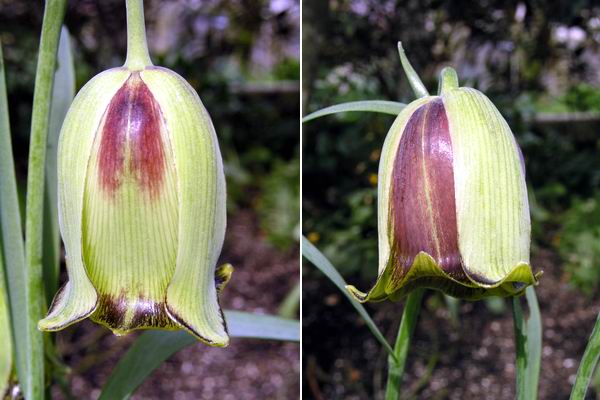
Fritillaria acmopetela
Fritillaria acmopetela is another of the later flowering species that is happy in the garden, seeding around and increasing by the masses of bulbils it produces every year. Again there is a considerable variation to be seen in the shape and colour of the flowers. Because this species produces so much rice, as does F. hermonis amana, I have a theory that if you have a collection of Fritillarias and you grow them for long enough they will eventually all turn into F. acmopetela or hermonis amana!
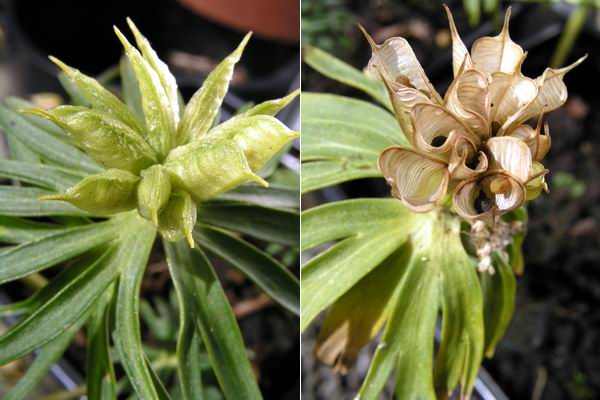
Eranthis seed heads
As you will have gathered from my logs and my talks, my big message is to grow from seed and to do that you have to collect seed. Many of the early bulbs have ripe seed on them now and you should be collecting it if you want to sow it in pots, scatter it elsewhere in the garden or send it to friends or the seed exchange.
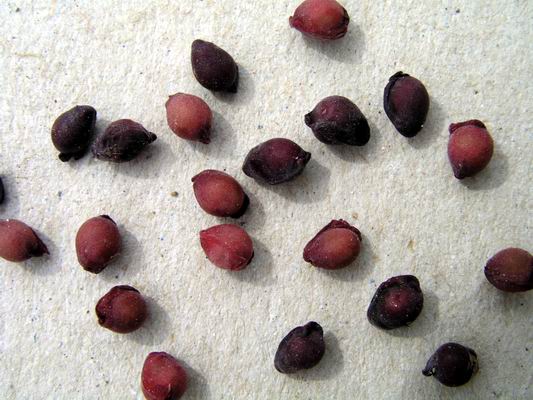
Crocus seeds
Enjoy your seed as you do the flowers and the bulbs - they are every bit as fascinating. In some cases it is even possible to identify the species from the form and colour of the seed. Now I am going over to an advertising break, please do not switch over or rush out to put the kettle on. Over 17,000 people visit the SRGC web site and read the bulb log every week and the vast majority are not SRGC Members. Access to our site is open and will remain that way but I want to tempt some of you to become SRGC Members by telling you how you would benefit even though you are not in Scotland. Around one third of our membership is not in the UK but they all enjoy receiving The Rock Garden, our twice yearly journal, fully illustrated in colour. It is held as one of the best specialist rock garden publications available with a wide range of topics to suit both the requirements of a beginner and the advanced specialist. The other great benefit for Members is the excellent SRGC SEED Exchange.

SRGC seed list
Members receive the list in December and can select from over 4000 different seed listings. I had a quick count up of some of the bulbous seed offered on this years list: 16 colchicum, 32 crocus, 61 cyclamen, 62 lilies, 26 erythronium, 22 trillium,46 narcissus, and so the list goes on. The seed exchange operates for a short time only and it is important to join in good time so you can participate in next year's seed exchange. To further tempt you to join the SRGC we are offering a special deal and if you join now we will extend your membership until the October 2006 renewal date. So; you will get the July Journal plus full membership for next year, 18 months for the price of 12, how can you resist that? An increase in Membership will greatly strengthen the SRGC and allow us to be even more ambitious in our objectives of spreading the word and the knowledge of plants. If you do decide to join you can do it on line, by credit card, using our secure payment pages: click on the Join Us link on the home page or yo
u can print out an application form and do it by post if you prefer. Single overseas Membership is US$25.00 and all the rates and details can be found by following this link.
Click here to find out about joining the SRGC
Whatever you decide I hope that you will all continue to enjoy our website. End of advert break!
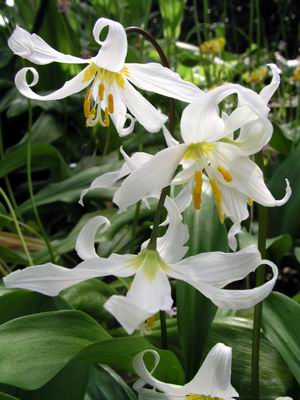
Erythronium montanum
I promised I would show you Erythronium montanum when it opened fully and they are now in full flower.
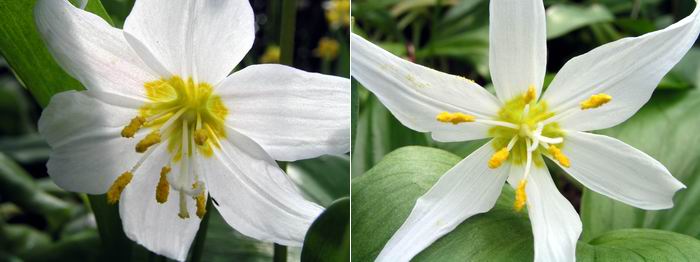
Erythronium montanum flowers
These also display a degree of variation when raised from seed but it is mostly in the shape and size of the petals. Erythronium montanum is always the last to flower but it is the first to ripen its seed, it has obviously evolved to grow very quickly in a short season.
^ back to the top ^
|

